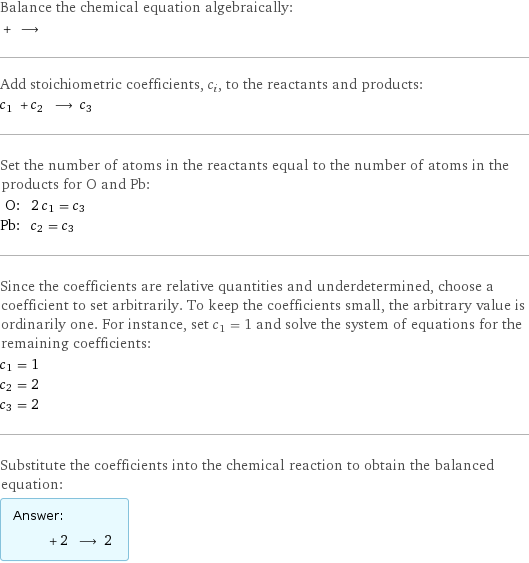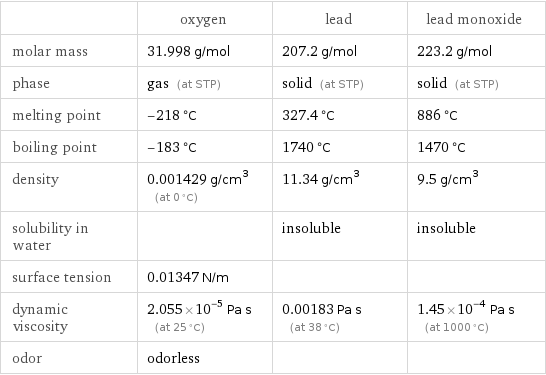Input interpretation

oxygen + lead ⟶ lead monoxide
Balanced equation

Balance the chemical equation algebraically: + ⟶ Add stoichiometric coefficients, c_i, to the reactants and products: c_1 + c_2 ⟶ c_3 Set the number of atoms in the reactants equal to the number of atoms in the products for O and Pb: O: | 2 c_1 = c_3 Pb: | c_2 = c_3 Since the coefficients are relative quantities and underdetermined, choose a coefficient to set arbitrarily. To keep the coefficients small, the arbitrary value is ordinarily one. For instance, set c_1 = 1 and solve the system of equations for the remaining coefficients: c_1 = 1 c_2 = 2 c_3 = 2 Substitute the coefficients into the chemical reaction to obtain the balanced equation: Answer: | | + 2 ⟶ 2
Structures

+ ⟶
Names

oxygen + lead ⟶ lead monoxide
Equilibrium constant
![K_c = [PbO]^2/([O2] [Pb]^2)](../image_source/1dffe9150f205918fd6ae8da81e1f326.png)
K_c = [PbO]^2/([O2] [Pb]^2)
Rate of reaction
![rate = -(Δ[O2])/(Δt) = -1/2 (Δ[Pb])/(Δt) = 1/2 (Δ[PbO])/(Δt) (assuming constant volume and no accumulation of intermediates or side products)](../image_source/ae8b8503c914d4b6220d45ca440797d5.png)
rate = -(Δ[O2])/(Δt) = -1/2 (Δ[Pb])/(Δt) = 1/2 (Δ[PbO])/(Δt) (assuming constant volume and no accumulation of intermediates or side products)
Chemical names and formulas

| oxygen | lead | lead monoxide Hill formula | O_2 | Pb | OPb name | oxygen | lead | lead monoxide IUPAC name | molecular oxygen | lead |
Substance properties

| oxygen | lead | lead monoxide molar mass | 31.998 g/mol | 207.2 g/mol | 223.2 g/mol phase | gas (at STP) | solid (at STP) | solid (at STP) melting point | -218 °C | 327.4 °C | 886 °C boiling point | -183 °C | 1740 °C | 1470 °C density | 0.001429 g/cm^3 (at 0 °C) | 11.34 g/cm^3 | 9.5 g/cm^3 solubility in water | | insoluble | insoluble surface tension | 0.01347 N/m | | dynamic viscosity | 2.055×10^-5 Pa s (at 25 °C) | 0.00183 Pa s (at 38 °C) | 1.45×10^-4 Pa s (at 1000 °C) odor | odorless | |
Units
